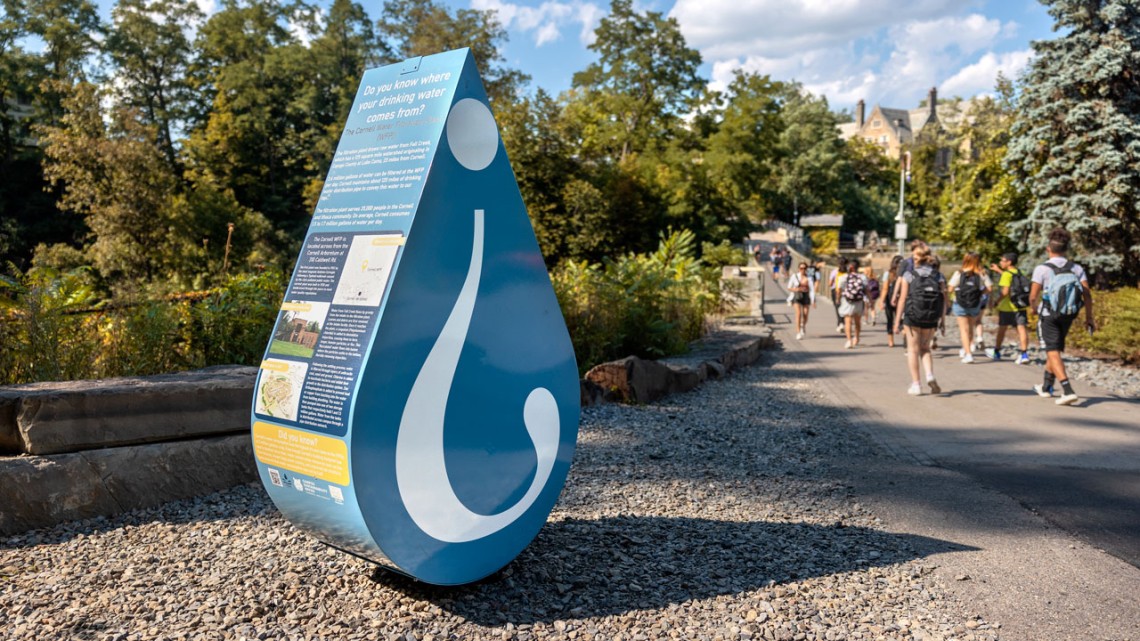
Two new educational “water drop” structures, developed by undergraduate students in a College of Human Ecology class, are now a Water Resources Institute reality.
Droplet-shaped sculptures kick off Year of Water
By Blaine Friedlander, Cornell Chronicle
Students walking to class – on different parts of campus – may notice two large, metal “water drops” packed with a torrent of information.
Turning on a faucet for a drink or cleaning dishes rarely elicits deep thoughts on how the water got there, but Brian Rahm, director of Cornell’s New York State Water Resources Institute, in the College of Agriculture and Life Sciences, realized that few students understood how drinking water here originates.
Even fewer, Rahm said, understood the integral role of Cayuga Lake to keep campus cool.
Welcome to the Water Resources Institute’s Year of Water – an educational effort to inform students and Tompkins County residents.
“Water is a critical resource,” Rahm said. “In Ithaca, it is easy to see the beauty and recreational value of water. But, while we implicitly value the importance of water in our lives, the water infrastructure – that we rely on for drinking, sanitation, cooling and power – is largely invisible to us or goes unrecognized.”
In 2019, before the pandemic, Rahm and the institute partnered with a class in the College of Human Ecology – a Design and Environmental Analysis (DEA 2203) spring course, Studio SHIFT, taught by senior lecturer Rhonda Gilmore – to develop a campaign to inform students and surrounding community on how water works.
Fourteen students conducted research and developed campaign plans for the water droplet sculptures, designed information stickers for residence halls and helped to commission a water-education mural created by local artist Norma S. Gutierrez at the Ithaca Farmers Market. The mural and signage will be installed later this fall, according to Rewa Phansalkar, M.R.P. ’21, WRI research and outreach specialist.
Gathering research, Gilmore’s students toured local facilities such as the Lake Source Cooling Facility, Cornell’s Hydroelectric Plant and Water Treatment Facility.
“It was fun to research and visit all the water facilities around campus, such as the Cornell Water Filtration Plant and Lake Source Cooling building,” said Luciana Ruiz Hafner ’19, a student in the class who has gotten to see the plans become reality. “It was very exciting to think that our work could have the potential to educate others around campus.”
Abigail Brown ’21, now a doctoral student in the College of Human Ecology, said: “I remember learning that all the water from taps on campus and pretty much throughout the Ithaca area is safe to drink and that it comes from Fall Creek.
“We are very fortunate to live in a place with such stable sources of water and a safe water infrastructure,” she said.
The water drop sculpture near the Hydraulics Lab (in the vicinity of the Thurston Avenue Bridge) describes how the Cornell Water Filtration Plant draws from Fall Creek, which itself has a 125-square mile watershed that originates in Cayuga County.
The creek water is treated to remove sediment, pathogens and contaminants. About 3.6 million gallons a day can provide enough water for campus and nearly 35,000 people in the surrounding Ithaca community. On average – with all the dining, laboratories, showers and bathrooms, Cornell consumes about 1.5 to 1.7 million gallons of water each day.
The other water drop – placed atop Libe Slope, behind Uris Library – explains how Cayuga Lake helps keep 80 campus buildings cool in the summer, through a process called Lake Source Cooling. Every minute about 33,000 gallons of chilly water is drawn from the bottom of the lake and becomes part of a campus loop to deliver about 20,000 gallons of cooling water. The water helps to chill about 4.5 million square feet of air-conditioned space. This process, the metal droplet said, eliminates about 86% of the carbon energy needed to cool campus.
“For Cornell students passionate about the environment, there’s value in connecting the physical and natural world around you,” Rahm said, “and knowing the connection between that and your daily life is quite valuable.”
In addition to Hafner and Brown, students who developed the Year of Water campaign are Abigail Auwaeter ’21; Tara Chen Sue, B.Arch. ’19; Hannah Harvey ’21; Olivia Heim ’21; Brandon Hoak ’21; Yun Mi Koh ’20; Annice Lee ’21, M.P.S. ’22; Arleigh Parr ’21; Sissy Shen ’21; Jessica Shin ’22; Vivian Shiu ’21; and Priscilla Tsang ’20, M.P.S. ’21.
Get Cornell news delivered right to your inbox.
Subscribe
